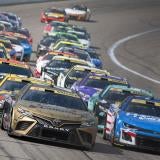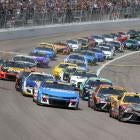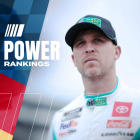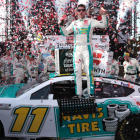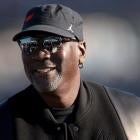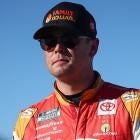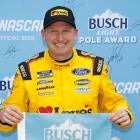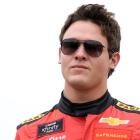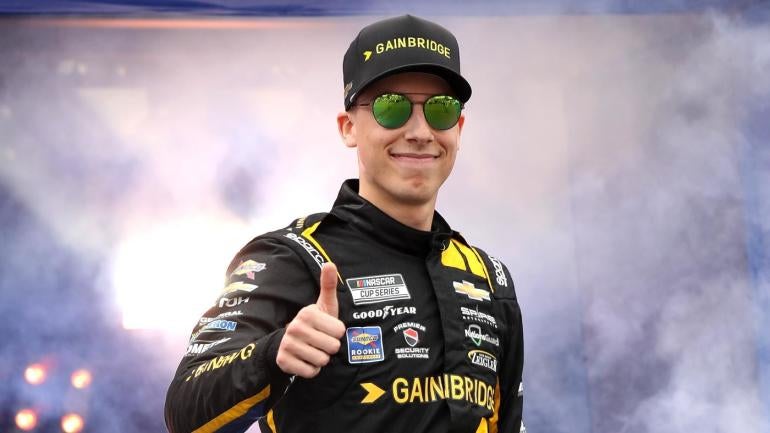
Growing up, when Carson Hocevar wasn't trying to see how fast he could go in pursuit of his dream of being a race car driver, he was often engaged in a slower derivative of the sport he loved. Bit by bit, he was moving his NASCAR diecast cars around a model track that he had built, snapping photos as he went along creating fictional races comprised of the same drivers he watched on television. Then, he brought them to life through the magic of stop-motion animation and shared the finished product for everyone to see on YouTube.
It was a much more deliberate and involved process than how past generations of kids played with their diecast cars. But for Hocevar and his competitors, it was a favorite pastime.
"Everybody who I would always race quarter midgets with was doing it. We would always compare," Hocevar told CBS Sports at Talladega. "We'd have a field of 10 for quarter midgets, eight of us would do it. So it was really funny to be like 'Oh, you're doing it too!'"
Was a solid day for the 99 team😂😂 time flies pic.twitter.com/7drU0hbsrU
— Carson Hocevar (@CarsonHocevar) December 8, 2021
Like many children before him, some of Hocevar's core memories of becoming a race fan began with diecast NASCAR cars, which he would play with on a counter space at the sports memorabilia store his parents owned and operated. However, the Internet -- specifically the highly immersive frontier of Web 2.0 -- availed him both ideas and opportunities for creative play that previous generations could only have imagined.
The discovery of diecast stop motion races and all sorts of other NASCAR content on YouTube proved an enormous influence on Hocevar as he grew up a NASCAR fan. But he's not alone in that regard, as rising Truck Series star and fellow Gen Z driver Rajah Caruth was also once a young race fan with a YouTube channel. And soon, he was creating and uploading races of his own while enjoying the work of other stop motion creators and series -- Eric Estepp's works and the Aflac Cup Series were particular favorites.
"It blew my mind that people this whole time, I was doing the same thing they were doing, just they were taking pictures and making videos of it," Hocevar said. "I took advantage of it. They were horrible as I had never used a computer before, so then that was the only reason I started using computers. I started getting better at it a little bit at a time. But it just really made it a lot more fun.
"As you're playing with toys and moving cars around, eventually you've had the same race and same storyline 10 different ways. Where now, it'd give me a week's worth of stuff to work on and it'd give me an end result that I was pumped and it'd allow me to change tracks and stuff. It kept me as a fan of diecasts and cars and collecting and having fun with that."
As his love of NASCAR crystalized through his diecast collection and through his generation's way of playing with them, Hocevar was also on what turned out to be a very fast track to making it to the highest levels of the sport. His family's business sponsored and employed a driver at Kalamazoo Speedway, and as they became ingrained in the culture of their local short track, the plan was to bring Carson up and along to becoming a speedway regular.
But as fate would have it, the Hocevars' driver-raced cars were built by Johnny Benson, a winning Cup Series driver and a champion in both the Xfinity and Craftsman Truck Series. The young Hocevar would wind up catching Benson's eye, and he quickly became his mentor and strongest advocate. Not only did Benson build and crew Hocevar's cars, but he also gave him the opportunity to race at the famed Berlin Raceway despite his exceptionally young age.
"All of a sudden he went from just gonna sell us a car, 'let us know what you need', to he drove the truck and trailer himself, he spotted, he crewed, he built the car, set up the car, spotted, everything," Hocevar said. "He wrote letters to every single driver at Berlin asking if a 12-year-old could race against them, and he put himself as the glowing reference. Without him I probably wouldn't have gotten to race Berlin, without him I wouldn't have learned so quickly. And without him, I wouldn't have learned how to race so quickly."
Johnny Benson mentoring Carson Hocevar at Eldora (via u/ryan49321) https://t.co/xhFPQT4gXn #NASCAR pic.twitter.com/K2vjzOHlqY
— r/NASCAR on Reddit (@NASCARonReddit) August 1, 2019
Since then, Hocevar's development into one of the top young talents in NASCAR has happened quickly and only gotten faster in the past year: After contending for the Craftsman Truck Series championship and impressing in limited Cup action late last year, Hocevar was tabbed to drive full-time this season for Spire Motorsports and has already taken advantage of the opportunity. The 21-year-old sits 21st in the points standings thanks to three top 15 finishes, six finishes inside the top 20, and his first career top 10 just two weeks ago at Texas, giving him an early advantage in the battle for Cup Rookie of the Year honors.
When asked if he's surprised himself with how fast he's gone from being a race fan on YouTube trying to make it at the local level to racing Cup on Sundays, Hocevar admitted that he could not have envisioned himself racing in Cup at this time last year when he had just figured out how to win Truck Series races. Hocevar's talent had been obvious in his first seasons driving trucks for Niece Motorsports, but he had gotten himself and his team in trouble multiple times -- putting himself at odds with management in the process -- by pressing while trying desperately to earn his first career win.
"We always knew deep down that we had a deep love for each other and wanted the best for each other. And sometimes I felt like I would let them down if I didn't perform, so that's all I cared about," Hocevar said. "You don't bring your friends to the racetrack, and I probably took that way to the extreme at times, and obviously that ruffles feathers and they're the guys that have to answer for that.
"So I had to kind of sit myself down and say 'Maybe it's okay, maybe I've just got to make sure I just keep this job', right? Not work so hard to get the next one. That I need to just succeed in this one, and the rest will take care of itself. But I said going into this if I just become a full-time Truck guy for the rest of my life, there's way worse things to be doing.
"And then sure enough once I started thinking like that, we started winning a lot of races, ran really well in Xfinity the few times I got a shot to do that. And then all of a sudden I had more Cup races than I did Xfinity races, and by the end of the year I had signed to run more years in Cup than I have in Trucks. So that part was pretty crazy."
With a major career milestone reached upon signing with Spire, it was then that Hocevar gave a strong nod to his roots: While at home for Christmas, Hocevar took diecasts of his own trucks that his mother had collected and made a short stop motion race, connecting himself to the race fan he once was in a full circle -- and very much new generation -- coming-of-age moment.
"It's funny to go back now and watch stop-motions with my name on it and cars of mine," Hocevar said. "And then now being a rookie in Cup, it's super surreal that it's come this full circle. Those visions in my memory are still very, very vivid and very detailed.
"I can almost tell you picture perfect where I was and what I was doing a handful of times. Those core memories of doing stop motions and making racetracks."









